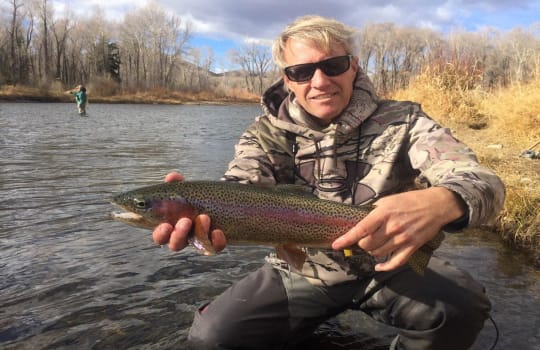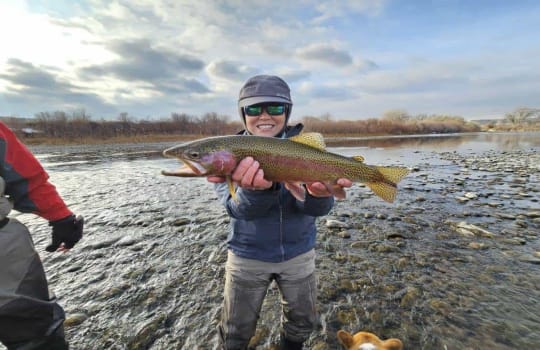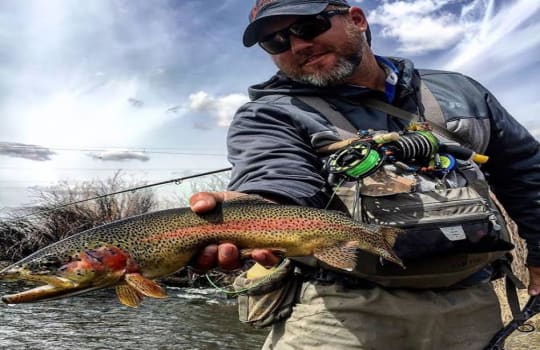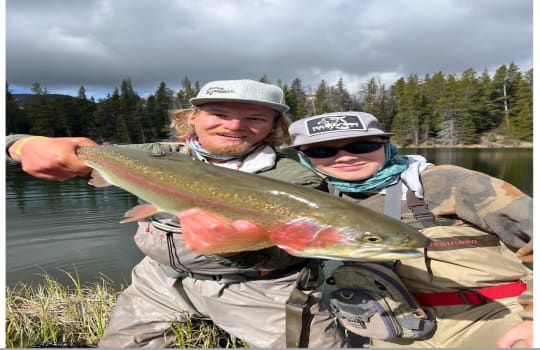
With the advent of Spring upon us I got to thinking; what are some of my favorite Early Spring patterns to prospect for hungry trout. One of my favorites is the Golden Stonefly Nymph, but what is a Golden Stonefly you might ask? Well, allow me to enlighten you.
A Stonefly is the common name for the order Plecoptera. The sizes of these insects range from 6 mm to 50 mm in length (excluding antennae and tail filaments) Golden Stoneflies usually don’t exceed 38 mm but are the most abundant of all large stonefly species in the West and most preferred by trout. Stoneflies are usually identifiable by their two tail filaments, paired claws on each of the six thoracic legs, and two distinctive wing pads on their second and third thoracic appendages.
Golden Stones thrive in both unregulated freestone streams and in tailwaters below deep bottom-release dams, so they are more common on more waters than the bigger Salmonflies. On the waters I guide, the South Platte River, and the Arkansas River, Golden Stones are a staple part of my Spring arsenal.

Golden Stoneflies are roughly the same size as Skwalas (17-23 mm). The nymphs are a speckled yellow brown and the adults range in color from a rich golden brown to dark brown, with lighter tones around the legs and on the underbelly. They could be easily confused with Skwalas if it weren’t for hatch timing. Skwalas are early spring stoneflies, while Golden Stones are summer species, most prevalent in the month following the Fourth of July.
As a result of the multiyear life cycles of the larger stonefly species, several different year classes live in the stream at any given time, and stonefly nymphs remain plentiful year-round, even after the adults have emerged. Since the trout see and eat nymphs all year, Western anglers should be prepared to fish them at all times—not just near peak hatch periods.
Nymphs are large and live in riffles and rocky, boulder areas with moderate to fast current. They often lose their grip and are taken all year by trout. An appropriate pattern dead-drifted near the bottom is effective. Choose your imitation carefully, however. Many fly shops sell a golden stonefly nymph that is golden in color, but the actual nymph is mottled shades of tan, black, and brown. However, when golden stonefly nymphs molt, the new instar can briefly be a much brighter color. It’s possible that trout key in on that brighter shade, which would explain why an imitation works when it seems to be unlike the color of the vast majority of the natural insects.
Golden Stonefly nymphs are important foods for trout on most Western watersheds through the entire year. In the weeks preceding the hatch, focus your efforts on the fast, rocky holding water near the banks. Barr’s Tungstones, Barr’s Tung Teasers, Pat’s Rubber Legs (brown/orange), Beadhead Hare’s-ear Nymphs, Orange Psycho Princes, and Mercer’s Golden Biot Stones (#8-10) are a few of the more popular Golden Stonefly nymph imitations.
Don’t rule out fishing stonefly nymphs in January, basing your decision simply on the time of year, or because you don’t see any. Throughout the winter months, tumbling ice chunks frequently dislodge stonefly nymphs from the substrate, creating a feeding frenzy.
I enjoy nymphing with Golden Stonefly Nymphs during the months of February and March when the Nymphs molt. Not only are they more active in the river at that time but they tend to be a little brighter than just before and after the molt. Keep in mind, this is not an emergence and you won’t see any winged adults – not until summer do they emerge. This is just a molting stage, kind of like a change of clothes if you will.
When fishing the nymphs make sure the flies you use are weighted enough to bump along the bottom or heavy enough to get down into those deep slots off drops.
During emergence, stoneflies migrate toward the river’s edge and crawl from the water onto streamside rocks, willows, grass, and trees to hatch into adults. You’ll see evidence of this process in the form of their empty exoskeletons clinging to bridge abutments and boulders along the river.
Because the hatch occurs on land, stonefly nymphs transitioning to adults (“emergers”) are not available to trout during the emerging process. But the heavy concentration of nymphs along the streambanks during the migrating process increases their availability at certain times of the year. Nymphing along the river’s edge is highly productive during these migration periods.
Not surprisingly, adult stoneflies look similar to the nymphs, with the exception of the two pairs of veined, folded wings—two forewings and two hind wings—over their backs.
Unlike mayflies and caddis flies, stoneflies do not produce mating swarms or spinner falls. Instead, they mate on land. Male and female stoneflies locate one another by drumming or tapping their abdomens on branches, tree trunks, and rocks. The male initiates one rhythmic pattern, which is subsequently answered by a female. Each species has its own unique drumming pattern.
Adult stoneflies consume fluid foods, and as a result sometimes live between one and three weeks before they find a mate. After they mate successfully, females fly over the water and drag their abdomens on the surface to deposit their eggs, but other than that, stoneflies rarely fly. They crawl to find and meet their mates.
The good news is that stoneflies are clumsy. They are easily dislodged by wind, and once airborne, they are poor fliers. They often end up in the water, where they flutter, creep, and clamber toward the shore, or drift aimlessly. If they aren’t eaten, they often drown and are washed downstream to be eaten submerged, as nymphs would.
The best dry-fly fishing occurs in the afternoon, when the adults come back to the water to deposit their eggs. The trout key on these egg-laying flights, and anglers can generally catch fish on the surface throughout the course of the day. Yellow and olive Stimulators, Rogue Foam Stoneflies (golden), and Amy’s Ants (olive) in #8-10 are excellent imposters.






